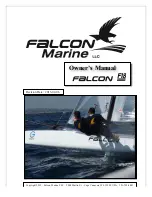
Copyright 4-1-06. All rights reserved, C-Dory Marine, Inc. Not to be copied, altered or distributed. 14
Revised 8/21/2007
Daily Inspection & Checklist
•
The boat and its systems should all be in good repair and properly serviced.
•
Inspect the steering system for visible damage.
•
With the motor tilted down, rotate the helm from full right to full left several times to check
for stiffness or poor response and that the motor can travel without restriction.
•
Open battery compartment(s) and check for fumes, loose wires. Check water level in
battery(s).
•
Cycle the bilge pump switch to test pump. Leave in the On-position.
•
Test navigation light system, radio and other navigation equipment.
•
Inspect safety equipment and insure that they are adequate and in good order.
•
If everything checked out “OK” then proceed to the next step. If not, correct problem(s)
before proceeding.
•
If boat is to be launched from trailer, close all below-water line drains (if any) and close all
through-hull valves (if any). Observe trailer manufacturer’s precautions and
recommendations and launch boat.
•
Load passengers & gear; balance load appropriately and safely.
•
Follow the motor manufacturer’s manual for pre-start-inspections and procedures for
startup. Observe all precautions and safety issues listed. Then start and warm the motors.
•
If you have plenty of gas and the motor(s) is running will, you are ready to go. Don’t forget
to untie the boat and bring your fenders aboard before pulling away from the dock!
•
The forward deck hatch should be used with caution when under way. If opened for
ventilation make certain that both support rods are locked. Do not open forward hatch if
operating boat at speeds above 25 knots. Secure hatch and lock latches before towing on
trailer.
•
Do not operate the boat at high speed with passengers on forward deck. Anchoring can be
accomplished safely while standing up through the forward hatch.
Safe Loading
•
Loads must be evenly placed about the boat.
•
Secure all loads; nothing should be tossed about.
•
No loads or passengers should be carried on the forward deck.
Maximum Gross Wight=8000 Lbs The maximum gross weight is the total weight of the
boat, motors, fuel, gear and passengers. Operating the boat at maximum gross weight
requires special care in loading. The boat must be loaded so as to maintain the correct attitude
fore and aft, and it must be kept level from side to side. Expect the boat to feel heavy (it is).
Normal Running Weight=7500 Lbs
The normal running weight is the total weight of the
boat, motors, fuel, gear and passengers. This is the design weight of the hull. When the weight
is properly balanced it will give the best average for speed, comfort and economy.
Note: Many people ask why the C-Dory 25’ does not have a Coast Guard capacity label like
the 16’ C-Dory -
•
The Coast Guard requires that all boats under the length of 20’, except canoes, kayaks and
inflatables, meet the requirements of the Boat Safety Act of 1973. These standards deal






































